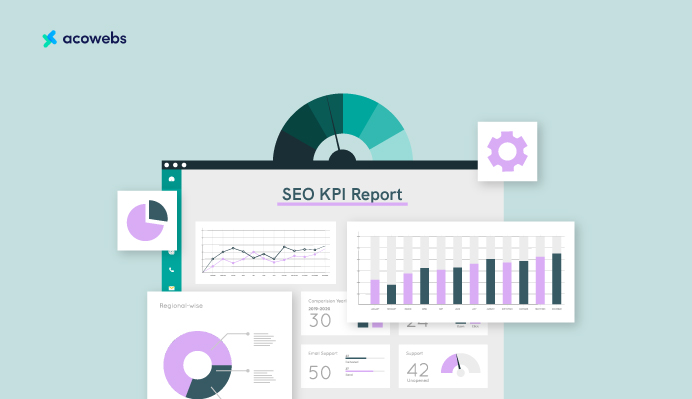Table of Contents
Getting your e-commerce site optimized might be challenging. It’s a drawn-out, protracted process, and success usually takes time.
While having long-term objectives to boost sales is critical, it’s also crucial to set incremental short-term objectives to improve search exposure, increase traffic, and raise conversion rates.
Key Performance Indicators (KPIs) monitoring and measurement provide a high-level picture demonstrating whether you are on the correct path or whether changes need to be made.
You must monitor several key effectiveness indicators for your digital marketing, specifically for the effectiveness of your Search Engine Optimization (SEO), to determine whether your SEO efforts were worthwhile given the time invested in your content marketing, meta descriptions, target keywords, etc.
There are so many significant SEO KPIs that it might be daunting. It takes a lot of work to compile your high-quality SEO stats from all the powerful SEO platforms for every SEO campaign.
This article will review the top ten most important SEO KPIs for eCommerce to help you understand which would work best for you.
What Are SEO KPIs

The success and efficacy of an SEO campaign are assessed using SEO KPIs, or Search Engine Optimization Key success Indicators, which are technical measures.
These KPIs give information on the user engagement, visibility, organic traffic, keyword ranks, and conversion rate of a website. You may learn a lot about the performance of your company’s website by monitoring SEO KPIs.
These indicators show how well your content optimization, backlink development, and other SEO strategies are working to increase your total reach and revenue.
With the help of SEO KPIs, you and your team can pinpoint areas that need work, decide based on facts rather than feelings, and monitor your development over time.
Understanding the customer’s goals for ranking for a specific term will enable you to offer more excellent value and better service.
Connecting KPIs to these business goals is crucial because it allows you to communicate with decision-makers in their language.
Rankings for keywords are lovely, but the value of organic search and your effort will be best demonstrated by a quantifiable percentage gain in sales from SEO or a reduced cost-per-lead for SEO compared to PPC.
KPIs, in a nutshell, serve as the link between your SEO efforts and the business’s goals and objectives.
Important SEO KPIs for eCommerce Websites
SEO KPIs are the most crucial SEO measures directly related to company expansion. You should pick the KPIs carefully since they dictate the activities you take.
Below are some of the ten most important SEO KPIs for eCommerce.
1. Organic Visibility
When customers search for your brand or relevant terms, organic visibility—also known as search visibility—measures how effectively your brand shows in search results.
Organic visibility extends beyond the conventional comparisons against the top ten blue links on a search engine results page (SERP) to demonstrate your company’s “share of voice” (SOV) in marketing terms.
It’s maybe the only non-conversion indicator that can be directly connected to the expansion of your firm because market share and SOV have a close connection. Generally speaking, your part of the pie increases with your SOV.

Additionally, it has a wide range of other SERP features, like local packs, knowledge panels, highlighted snippets, and an ever-expanding list of different components.
You may use tools such as Google Search Console, which summarizes your search impressions over a specified timeframe, to measure or track your organic exposure.
Even if those searches didn’t lead to clicks, the sheer amount of impressions shows how frequently your website appeared in search results. This indicator shows the steady improvement in your visibility and the categories of queries in which your site was found.
Enhancing your organic exposure has several benefits since it expands your prospective consumer base. You may reach a broader audience and improve your chances of obtaining worthwhile organic traffic by improving the exposure of your business.
2. Organic Conversion Rate
The percentage of leads or prospects who become actual paying customers is tracked by the total sales conversion rate, which is undoubtedly among the most critical SEO KPIs for eCommerce websites.
This KPI evaluates your company’s capacity to produce leads and create actual income from those leads, which is the primary objective of most enterprises.
To put it another way, the performance, profitability, and future viability of your company are all strongly correlated with the sales conversion rate as a KPI.
A high conversion rate shows that you are successfully converting a large percentage of your leads into customers, boosting sales and income.
However, a poor sales conversion rate may indicate that your sales funnel needs modification or that your marketing or sales tactics need to be tweaked.
3. Bounce Rate
The percentage of visitors to a website’s page who subsequently depart the site without taking any further action is known as the bounce rate.
It acts as a straightforward yet illuminating indicator of your write-up’s interest and how closely it adheres to the keyword queries that initially brought readers to your website.
Unlike many others, having a “high score” for this SEO KPI is not a good thing. A high bounce rate frequently indicates that your page must grab visitors’ interest or attention to increase conversion rates.
A high bounce rate, however, denotes subpar website performance. Low average session lengths might also have a detrimental effect on your search engine results.
You may find areas for improvements on specific pages and make minor adjustments that, over time, result in extensive improvements in user engagement by routinely monitoring bounce rates.
Additionally, it’s beneficial to evaluate the bounce rates of particular blog posts and landing pages along with your website’s general bounce rate to spot any sections of your site that may require special attention.
You may enhance conversion rates and company success by making your site more likely to keep visitors on the page and encourage them to read further.
4. Click Through Rate
The click-through rate (CTR), a crucial SEO indicator, assesses how well your search engine listings perform in luring clicks, indicating interest, and engaging users.
Tracking CTR at both the page and query levels is essential for assessing the success of your content, despite the fact that it is not a verified, direct ranking factor in terms of conversions or income.
CTR is the proportion of visitors who click on your website from the search engine results page (SERP) after seeing it there. The greater your CTR is anticipated to be, the higher your rank.
You may evaluate the suitability of your title tags and meta descriptions shown in the SERPs in relation to users’ searches by tracking CTR. The performance report in Google Search Console may be used to examine CTR for your pages and queries.
It offers insightful information on the percentage of SERP impressions that end up as clicks, providing an overview of how effectively your search engine listings draw in visitors.
Additionally, consistently tracking and improving your CTR unavoidably increases your website’s traffic and exposure, resulting in better engagement and helping you reach your SEO objectives.
5. Keyword Rankings
Since it offers information on the functionality and visibility of your website in search engine results for relevant keywords, keyword ranking is among the most essential SEO KPIs for eCommerce website.
Businesses used to mostly monitor minor keywords to evaluate the effectiveness of their SEO strategies. However, as semantic search has grown and developed, a single page of information may now rank for various keywords and search contexts.
In any case, tracking keyword rankings enables you to determine which terms are most effective in bringing visitors to your website and affecting your overall company results.
High search ranks often correlate with more website visitors, qualified leads, and maybe greater conversion rates.
One can evaluate the success of their content and make wise improvements to their SEO approach by remaining updated about the phrases one ranks highly for and ones that may require more exposure.
According to research by Databox, nearly 75% of the businesses surveyed specified top keywords as their SEO objectives.

6. Page Load Time
A quick page load time is essential for a satisfying user experience. Page load time directly affecting several metrics and long-term search engine rankings is another vital element in website performance and user experience.
For instance, if a website loads slowly, there is a higher chance that people will leave and bounce off the page.
According to research, a website should only take three seconds to load; otherwise, 40% of the visitors will quit. Due to user annoyance and high bounce rates caused by delayed loading times, user engagement and conversion rates might suffer.

Page load speeds may be severely impacted by large photos, videos, and GIFs.
Therefore, even while such aesthetically attractive material may improve user experience, if it causes slight delays in page loading, it may encourage users to hit the return button and look for alternatives.
Corresponding to this, cutting two seconds off Mozilla’s landing pages increased conversions by 15.4%, translating to 60 million additional downloads annually.

Any change you can make—even if only in two seconds—could help your company.
Tools like PageSpeed Insights may help evaluate and improve the page load times for your website. These tools provide data on load times for various platforms and pinpoint certain causes of sluggish site performance.
Let’s say you want to speed up how quickly your pages load. In such a situation, you may consider a variety of tactics, including lowering the amount of HTTP requests, using browser caching, reducing server response time, and optimizing picture sizes.
Ultimately, website owners may improve user experience, lower bounce rates, and boost their overall search engine results by emphasizing quick and efficient loading.
7. Return on Investment (ROI)

Return on Investment, or ROI for short, is a crucial measure used in many different kinds of enterprises since it assesses the financial gains from capital spent on a particular project.
By comparing the value (typically sales) you get from organic conversions to the price of your SEO efforts, ROI illustrates your SEO strategy’s effectiveness (or lack thereof).
The formula for calculating SEO ROI is as follows: Take the value of organic conversions, remove the cost of SEO investments from it, divide the result by the cost of SEO expenditures, and multiply the result by 100. The ROI is expressed as a percentage using this formula.

However, since it takes a long time to see noticeable effects, calculating SEO ROI may be difficult.
The full effect of SEO work may not be seen for many months or even an entire year, particularly for projects like landing page optimization.
The main goal of an SEO strategy is to provide a positive ROI, notwithstanding the challenges involved in calculating SEO ROI precisely.
It shows that the efforts to create content, maintain websites, and conduct outreach activities have been fruitful.
Setting clear objectives, monitoring pertinent measures, and examining trends over a long period are essential.
Additionally, combining ROI analysis with other SEO KPIs, such as organic traffic, conversions, and keyword rankings, gives you a thorough insight into your SEO operations’ total effect and worth.
In the end, SEO ROI acts as a guiding indicator that aids in assessing the financial feasibility of your SEO efforts and the decision-making process for resource allocation and strategy optimization.
8. Backlinks
For many organizations, backlinks are among the crucial part of their SEO KPIs for eCommerce.
They effectively function as links on other websites that point readers to your website and serve as “words of recommendation” to search engines like Google, demonstrating the authority and popularity of your website.
Backlinks are essential for increasing your website’s exposure in search engine results since Google values them as one of its top ranking criteria.
To evaluate the strength of your link profile against your rivals, it is also crucial to look at several link metrics. You should take the following factors into account while calculating backlinks:
- The number of referring domains
- The overall quantity of backlinks
- The number of fresh connections added and the number of links removed over time
The sum of these measures offers information on the development and reliability of your backlink profile.
Furthermore, the amount and quality of backlinks matter, even though some businesses get caught up in a numbers game.
The more connections your website receives, the better, but you must prioritize reputable and authoritative sites since they will value and trust your material more.
Knowing the backlink environment also requires doing competitive analysis. You may establish benchmarks and spot possibilities to enhance your link profile by looking at the backlinks your rivals have obtained.
Concentrate on producing exciting and quality material that organically draws backlinks, developing connections with other website owners, writing as a guest, and participating in industry partnerships to increase the number of backlinks pointing to your website.
Regarding tracking, programs like Ahrefs, SEMrush, and Moz provide quick access to your backlinks’ quantity, domain authority, toxicity score, referring domains, and spam score.

9. Organic User Lifetime Value
Driving traffic to your website via SEO efforts is one thing, but the fundamental objective should be to drive relevant visitors.
Lifetime value monitoring has been available in the Google Analytics beta program for some time and has shown to be pretty helpful.
Into default, lifetime value is segmented into channels, making it simple to see the worth of organic search users over time.
Ranking for more relevant keywords or a better on-site user experience may be linked to an increase in the lifetime value of organic users over time.
Compare lifetime value to assess how organic traffic stacks up against other methods of SEO KPIs for eCommerce.
Consider the knowledge that consumers may have had while arriving from other channels when examining this data. How can you provide such information to site visitors who come naturally?
10. Branded and Unbranded Traffic
When examining website traffic, it’s crucial to differentiate between branded and non-branded traffic. Branded traffic consists of customers already acquainted with your company or who have heard good things about it.
However, branded traffic is not commonly regarded as an SEO KPI since it does not directly measure the performance of your SEO operations, even if it does show the success of certain marketing channels.
Alternatively, non-branded traffic is made up of people who find your website by using search terms related to the goods or services you provide.
Before finding your company on search engine results pages, these people may not have heard of it. Therefore, tracking the ratio of branded to non-branded traffic is essential for assessing the success of your SEO campaign.
You may use sophisticated filters in applications like Semrush’s Organic Research tool to measure this parameter.

You may concentrate on estimating the number of people that reached your website by expressly looking for your services or goods by filtering out branded searches that include your business name, for instance.
Comprehending the proportion of branded and non-branded traffic offers you a complete picture of the performance of your website. It enables you to modify your SEO approach to increase exposure among new clients and promote your business objectives.
Conclusion
In conclusion, choosing and monitoring the proper SEO (KPIs) is essential for organizations that want to assess the efficacy of their SEO tactics and make informed choices.
By increasing their exposure, generating more organic visitors, and increasing sales conversion rates, companies may benefit from SEO KPIs for eCommerce optimization and experience long-term development and success in the digital sphere.
Aim for consistent growth from year to year as you start monitoring the results of your SEO KPIs for eCommerce website. You could see progress in the first month, but it will probably take many months of data collection before you can assess the success of your efforts.
SEO is a long-term approach, and results don’t happen overnight. But the following rewards will be worth enduring if done effectively and consistently.
Acowebs are the developers of the WooCommerce Product Labels let customers include custom product labels or product badges for the Woocommerce products. Woocommerce product label plugin provides you with different label styles and customizations for labels. It also has developed various other plugins like WooCommerce Currency Switcher, the multi-currency converter plugin that shows prices in the user’s local currency and helps customers connect to desired products faster. It helps customers quickly compare products and make a judgment easily.











 Login
Login
 Cart
Cart








